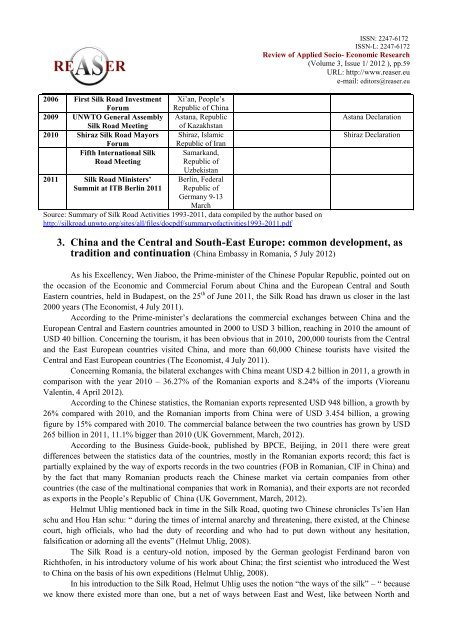Volume 3, ISSUE1/2012 - Review of Applied Socio-Economic ...
Volume 3, ISSUE1/2012 - Review of Applied Socio-Economic ...
Volume 3, ISSUE1/2012 - Review of Applied Socio-Economic ...
Create successful ePaper yourself
Turn your PDF publications into a flip-book with our unique Google optimized e-Paper software.
ISSN: 2247-6172<br />
ISSN-L: 2247-6172<br />
<strong>Review</strong> <strong>of</strong> <strong>Applied</strong> <strong>Socio</strong>- <strong>Economic</strong> Research<br />
(<strong>Volume</strong> 3, Issue 1/ <strong>2012</strong> ), pp.59<br />
URL: http://www.reaser.eu<br />
e-mail: editors@reaser.eu<br />
2006 First Silk Road Investment<br />
Forum<br />
2009 UNWTO General Assembly<br />
Silk Road Meeting<br />
2010 Shiraz Silk Road Mayors<br />
Forum<br />
Fifth International Silk<br />
Road Meeting<br />
2011 Silk Road Ministers’<br />
Summit at ITB Berlin 2011<br />
Xi’an, People’s<br />
Republic <strong>of</strong> China<br />
Astana, Republic<br />
<strong>of</strong> Kazakhstan<br />
Shiraz, Islamic<br />
Republic <strong>of</strong> Iran<br />
Samarkand,<br />
Republic <strong>of</strong><br />
Uzbekistan<br />
Berlin, Federal<br />
Republic <strong>of</strong><br />
Germany 9-13<br />
March<br />
Source: Summary <strong>of</strong> Silk Road Activities 1993-2011, data compiled by the author based on<br />
http://silkroad.unwto.org/sites/all/files/docpdf/summary<strong>of</strong>activities1993-2011.pdf<br />
Astana Declaration<br />
Shiraz Declaration<br />
3. China and the Central and South-East Europe: common development, as<br />
tradition and continuation (China Embassy in Romania, 5 July <strong>2012</strong>)<br />
As his Excellency, Wen Jiaboo, the Prime-minister <strong>of</strong> the Chinese Popular Republic, pointed out on<br />
the occasion <strong>of</strong> the <strong>Economic</strong> and Commercial Forum about China and the European Central and South<br />
Eastern countries, held in Budapest, on the 25 th <strong>of</strong> June 2011, the Silk Road has drawn us closer in the last<br />
2000 years (The Economist, 4 July 2011).<br />
According to the Prime-minister’s declarations the commercial exchanges between China and the<br />
European Central and Eastern countries amounted in 2000 to USD 3 billion, reaching in 2010 the amount <strong>of</strong><br />
USD 40 billion. Concerning the tourism, it has been obvious that in 2010, 200,000 tourists from the Central<br />
and the East European countries visited China, and more than 60,000 Chinese tourists have visited the<br />
Central and East European countries (The Economist, 4 July 2011).<br />
Concerning Romania, the bilateral exchanges with China meant USD 4.2 billion in 2011, a growth in<br />
comparison with the year 2010 – 36.27% <strong>of</strong> the Romanian exports and 8.24% <strong>of</strong> the imports (Vioreanu<br />
Valentin, 4 April <strong>2012</strong>).<br />
According to the Chinese statistics, the Romanian exports represented USD 948 billion, a growth by<br />
26% compared with 2010, and the Romanian imports from China were <strong>of</strong> USD 3.454 billion, a growing<br />
figure by 15% compared with 2010. The commercial balance between the two countries has grown by USD<br />
265 billion in 2011, 11.1% bigger than 2010 (UK Government, March, <strong>2012</strong>).<br />
According to the Business Guide-book, published by BPCE, Beijing, in 2011 there were great<br />
differences between the statistics data <strong>of</strong> the countries, mostly in the Romanian exports record; this fact is<br />
partially explained by the way <strong>of</strong> exports records in the two countries (FOB in Romanian, CIF in China) and<br />
by the fact that many Romanian products reach the Chinese market via certain companies from other<br />
countries (the case <strong>of</strong> the multinational companies that work in Romania), and their exports are not recorded<br />
as exports in the People’s Republic <strong>of</strong> China (UK Government, March, <strong>2012</strong>).<br />
Helmut Uhlig mentioned back in time in the Silk Road, quoting two Chinese chronicles Ts’ien Han<br />
schu and Hou Han schu: “ during the times <strong>of</strong> internal anarchy and threatening, there existed, at the Chinese<br />
court, high <strong>of</strong>ficials, who had the duty <strong>of</strong> recording and who had to put down without any hesitation,<br />
falsification or adorning all the events” (Helmut Uhlig, 2008).<br />
The Silk Road is a century-old notion, imposed by the German geologist Ferdinand baron von<br />
Richth<strong>of</strong>en, in his introductory volume <strong>of</strong> his work about China; the first scientist who introduced the West<br />
to China on the basis <strong>of</strong> his own expeditions (Helmut Uhlig, 2008).<br />
In his introduction to the Silk Road, Helmut Uhlig uses the notion “the ways <strong>of</strong> the silk” – “ because<br />
we know there existed more than one, but a net <strong>of</strong> ways between East and West, like between North and








